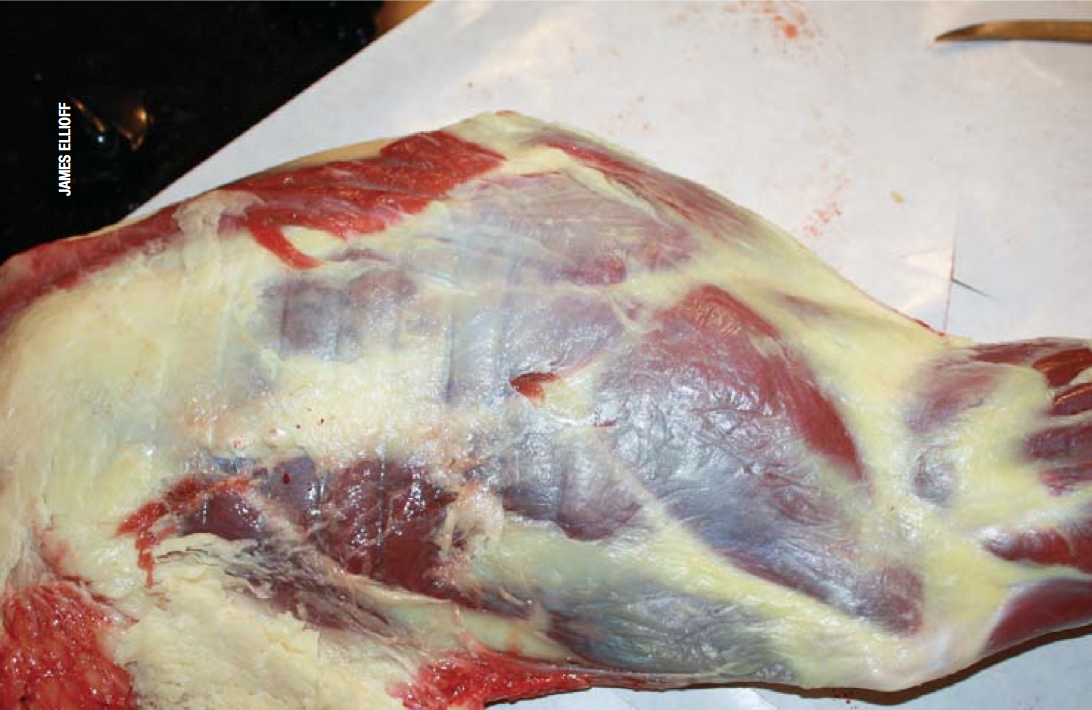Have you ever skinned a deer only to discover its meat was covered with a nasty-looking yellowish fat (not the normal ivory-white tallow)? Ever wonder why that happens?
Research shows that a deer’s sex, age and physical condition closer to winter are the three biggest factors affecting fat coloration.
No matter how many whitetails we see in a given year — or butcher during hunting season — there will always be new things to learn. Case in point: the venison in this photo and, specifically, the yellowish fat on the meat.
My friend Jay Ellioff, who is a part-time videographer for D&DH-TV, shared these images of a deer he shot in 2016 and then processed in Wisconsin. He was perplexed by the color of the fat and wanted to know if it would affect the meat.

Coloration of fat in whitetails is a fascinating topic and one we have covered from time to time in Deer & Deer Hunting. Esteemed deer behaviorist Dr. Leonard Lee Rue III first reported on this topic more than 25 years ago. His observations, along with those of deer researcher Dwayne R. Etter of Illinois, have provided the most insights on fat coloration in popular literature. During their careers, both men inspected thousands of deer carcasses.
According to Etter, a deer’s sex, age and physical condition closer to winter are the three biggest factors affecting fat coloration. Yearling deer — both bucks and does — that are in good condition typically display the almost pure-white fat that’s commonly seen by hunters who butcher their deer in October and November. Fawns, especially later in the season, will often display yellowish fat layers.
Older bucks are more likely to exhibit fat that’s a deeper shade of yellow — and even reddish in some cases. Fat starts turning color when it is being metabolized.
T.P. Kistner of the Oregon Department of Fish and Wildlife was one of the first researchers to document the physiology of deer-fat deposits in deer when he authored the manual “Technique for Evaluating Physical Condition in Deer” in 1980. His studies concluded that deer fat turns white when it forms and is stored on a deer’s muscle tissue and around the heart, liver and other internal organs.
Most hunters never see the yellow or red phases because they harvest their deer before winter sets in. In other words, stress — be it from an intense, prolonged rutting season or from the onset of harsh winter weather — along with nutritional deficiencies will cause a deer’s fat reserves to switch from ivory-white to phlegm-yellow in short order.
So … is it OK to eat this deer?
Absolutely. As with any deer, I recommend removing as much fat as possible from the carcass during the field-dressing process. Warm fat is easy to remove from the inside tenderloins and organs simply by pulling it free with your fingers. Then, during the butchering process, peel away the layers of fat along the backstraps, shoulders and hams as best you can. Use a fillet knife, if necessary, to trim away as much fat as possible before packaging up your cuts for the freezer.
Remember, that “gamey” taste that’s often associated with venison comes directly from fat. The more you remove, the less you will have to worry about any off flavors in your favorite venison dishes.
Let’s Eat!
Great Grilled Backstraps
Submitted by Jacob Pollock
Venison backstraps, cut to 6-inch lengths
Milk
1/8 cup worcestershire sauce
Salt and pepper to taste
Onion
Garlic
1 stick butter
Place chunked backstraps in a large bowl. Fill halfway with milk, then add water until almost full. Add worcestershire sauce and desired amounts of onion, salt and pepper and garlic. Melt butter and add to mixture. Allow meat to marinate for at least 4 hours, puncturing often with a fork to allow the marinade to soak in. Remove and grill to desired doneness.
+++++

